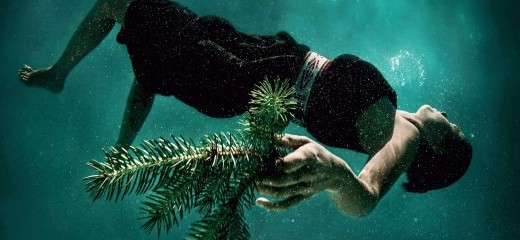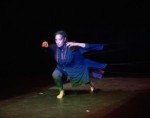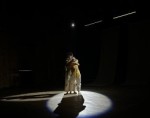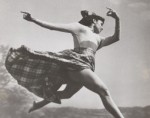
Chasing the Dance at the Barnes’ Southwest Native Art Exhibition
by Jonathan Stein
When the maverick, pioneering art collector and educator Dr. Albert C. Barnes attended the winter Deer Dance at San Ildefonso Pueblo in early 1931 he had a transformative experience. On this trip to Santa Fe and the surrounding Pueblo villages, he wrote an exuberant description of the experience to Henri Matisse in Paris, who was working on the Barnes commissioned three panel mural, The Dance, now animating a wall at the Barnes Foundation. He described the dance, one of many Pueblo dances that offer prayers for harmony in the universe and thanks to animals as a source of life, as a religious ceremony having “deep meaning” for the several hundred participants. Penn Museum of Archaeology and Anthropology curator Lucy Fowler Williams writes that Barnes often spoke of how the experience and “spirit of Santa Fe” was profoundly moving for him. (1)
Contrary to Barnes's prior modernist art collecting, in Barnes’s trips to the Southwest he experienced art in a social and historical context. In contrast to the European art he had been enamored of, this art with ancient roots was fully integrated into the spiritual and material lives of the Pueblo and Navajo people. From 1930-1931, Barnes collected 239 Pueblo and Navajo ceramic pots, woven textiles and silver and shell jewelry. What Barnes’s intellectual and formalist art preoccupations may have denied him was a recognition of the oppressive Spanish and American colonial histories that threatened this art and the Pueblo and Navajo people.
“Water, Wind, Breath: Southwest Native Art in Community,” is the first exhibition to focus on this work. This must-see exhibition not only presents its historic collection with Penn Museum loans going back to the 10th C., but also includes the art of over two dozen Southwest contemporary native artists. The title derives from the Tewa Pueblos’ term, Po-wa-ha (water-breath-wind), as the animating energy of life and of those practices nurturing life. In these stunning contemporary works, rarely exhibited outside the Southwest, I felt the indominable spirit of the artists and their life-force connections to the generations that resisted colonial efforts to erase them. Williams and Tony Chavarria (Santa Clara Pueblo), curator of ethnology at the Museum of Indian Arts and Culture, Santa Fe, co-curated “Water, Wind, Breath.”
The excellent exhibition catalogue includes Chavarria’s enlightening personal essay on Pueblo dance, particularly the Deer Dance, which he has performed at Santa Clara Pueblo. In a recent phone interview, I asked him to speculate why the Deer Dance might have had such a dramatic impact on Barnes during his January 1931 visit to the nearby San Ildefonso Pueblo. (2) Chavarria said that it likely resonated with Barnes much as it would with a contemporary viewer. In the dead of winter, he saw inter-generational farmers in antlered headdresses perform spirited dance and songs over hours in the sacred space of the Pueblo plaza. This connection with ancient practices and traditions is more powerful than mere performance for tourists. In his essay, Chavarria shares a detailed description of his own childhood feast day dance experiences that allowed him to “tread the path of my ancestors.” As he explained, “Pueblo dances are four-dimensional prayers in that they involve the sights, sounds, and movements of the current world, as well as those of the world beyond. In these prayers the spaces and social dimensions of the Pueblo are reflected back from the spirit world."
Where is the dance at this exhibition? While dance is fundamental to Southwest Native American life and culture, it is painfully elusive in “Water, Wind, Breath.” The Barnes’s decision not to include archival or contemporary images or film of dances is a missed opportunity. There is no plan to include live Southwest dance before the end of the exhibition, even as COVID diminishes.
The Barnes’s skirting of live dance performance has been true at other major museums as well. One recent example is the Senga Nengudi show’s absence of live dance for a dance-connected sculptor at the Philadelphia Museum of Art. In a 2016 interview with the Pew Center for Arts & Heritage, Barnes director Thom Collins shared that the “immediacy of live performance has a very special power” to “unpack histories and ideas” of a museum exhibition. The Barnes still has time to remedy this lapse before the show closes in May.
Seeking the covert dance at the “Water, Wind, Breath” exhibition became a kind of unexpected, pleasurable treasure hunt for me. Chavarria offered a clue when he pointed out that the Pueblo silver and shell jewelry and the embroidered dresses and woven textiles on exhibit were all worn by dance participants and their observers. He described the observers as “active listeners”—and highlighted that the costumes, jewelry, and observers are all elements of the dance.
I did find some striking examples of more direct reference to dance. In Water Memory (1977), a large digital photograph by Cara Romero, a costumed man and a woman--likely pertaining to the Corn or Harvest Dance--float submerged in green/blue water, their bodies facing upward toward sunlight penetrating the deep. The woman offers us a bough of evergreens, a symbol of long life. Above her, the bare-chested man, whose head and neck are enshrouded with feathers and ornaments, extends his arms toward the surface and the source of the light. Chavarria explains that every Pueblo dance includes a prayer for water or rain. This memory image could reference historic memories of drought, especially the infamous one in the 13th C. that brought about a great migration of the Pueblo ancestors. Too, it could be a memory of abundant waters when a devastating drought re-occurs.

Debra Yepa-Pappan, Blessings, 2016, digital inkjet print image
In Debra Yepa-Pappan’s digital print, Blessings (2016), we see the artist’s daughter as Pueblo dancer. Like many in the Southwest Native American diaspora, she has traveled home to participate in their annual feast day dances with families and friends to experience a communal physical and spiritual regeneration. She has turned her back to us, body in repose, dressed, most likely, for a Corn or Harvest Dance at Jemez Pueblo. She wears a black woolen manta dress, tableta headdress, shell jewelry and deerskin moccasins, carrying evergreen boughs in each hand. Yellow gold coloring accents her tableta, sleeves, hem and moccasins. The image’s title may reference dance as a blessing from earth back to earth, or blessings from parent to child to return to her cultural and communal roots. The dancer’s image is set upon a ledger book grid (a subtle reference to Plains ledger art of the 19th C.) whose text lists gold jewelry being inventoried and sold. Does this gold reflect a blessing? Or, a suggestion that this dancer’s blessings transcend those of material wealth.
 RamonaSakiestewa Hopi.jpg)
Ramona Sakiestewa, Basket Dance, 1991, wool cotton
In the Hopi artist Ramona Sakiestewa’s wool and cotton Basket Dance (1991) we see in bold yellow, orange and primary colors the motifs of mountains and stepped-clouds (think gods traveling up and down heavenly terraces) taken from Pueblo baskets used in the Basket Dance. This dance honors women and the renewal that spring presents. At one point in the dance, women scrape rasps on overturned baskets said to produce sounds of grinding corn or the grinding from the melting of winter’s ice.
 (1).jpg)
Virgil Ortiz, Tahu Ambush, 2014, from The Revolt 1680/2180 Saga, digital image
In the 1883 federal Code of Indian Offenses, native religious and cultural practices, including sacred dances, were made illegal upon penalties of withholding of government rations and incarceration. This exhibition acknowledges this history of repression and the resistance that arose such as the great Pueblo Revolt of 1680, the largest successful revolution on the lands that are now the United States. The movement-embodying image reflective of this history of resistance is best represented in Virgil Ortiz’s digital image, Tahu Ambush (2014) from his futuristic Revolt 1680/2180 series. The Pueblo woman warrior Tahu, blinded as a punishment by Spanish colonial invaders, battles them with a recruited army of fellow blind archers. Three of these warriors dressed in menacing black point drawn arrows directly at us.
Thus it is current artists who, with a historical and political consciousness represent contemporary Pueblo life and culture, and remind us that the life-force energies of Po-wa-ha must also sustain the resistance against cultural oppression.
Barnes Foundation, Water, Wind, Breath: Southwest Native Art in Community, Feb. 20-May 15.
1. Lucy Fowler Williams, “In the Shadows of Paradise: Albert C. Barnes and the Spirit of Santa Fe,” p. 10, exhibition catalogue Water, Wind and Breath: Southwest Native Art in the Barnes Foundation.
2. Barnes likely observed other Pueblo dances at the time, like the Mountain Sheep Dance, pictured above on the tD homepage, which is performed at the same San Ildefonso Pueblo on the January 22nd Vespers night or on the 23rd, the saint’s feast day celebration.
By Jonathan Stein
March 9, 2022









